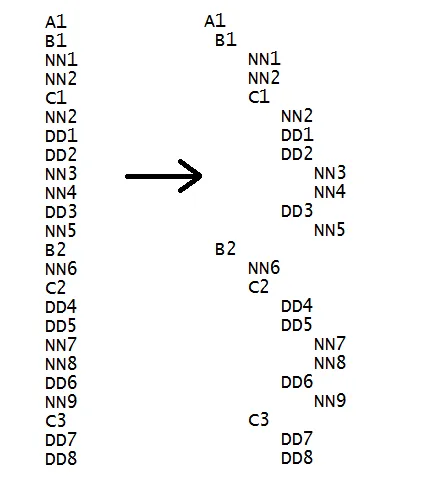这不是一道作业题。这个问题是在面试测试中问我的一个朋友的。
我有一个从文件中读取的行列表作为输入,每行开头都有一个标识符,例如(A,B,NN,C,DD)。根据标识符,我需要将记录映射到单个对象A中,其中包含对象的层次结构。

层次结构描述: 每个A可以有零个或多个B类型。 每个B标识符可以有零个或多个NN和C作为子级。同样,每个C段落可以有零个或多个NN和DD子级。每个DD可以有零个或多个NN作为子级。
映射类及其层次结构:
所有类都将具有“value”,以保存当前行的字符串值。
**A - will have list of B**
class A {
List<B> bList;
String value;
public A(String value) {
this.value = value;
}
public void addB(B b) {
if (bList == null) {
bList = new ArrayList<B>();
}
bList.add(b);
}
}
**B - will have list of NN and list of C**
class B {
List<C> cList;
List<NN> nnList;
String value;
public B(String value) {
this.value = value;
}
public void addNN(NN nn) {
if (nnList == null) {
nnList = new ArrayList<NN>();
}
nnList.add(nn);
}
public void addC(C c) {
if (cList == null) {
cList = new ArrayList<C>();
}
cList.add(c);
}
}
**C - will have list of DDs and NNs**
class C {
List<DD> ddList;
List<NN> nnList;
String value;
public C(String value) {
this.value = value;
}
public void addDD(DD dd) {
if (ddList == null) {
ddList = new ArrayList<DD>();
}
ddList.add(dd);
}
public void addNN(NN nn) {
if (nnList == null) {
nnList = new ArrayList<NN>();
}
nnList.add(nn);
}
}
**DD - will have list of NNs**
class DD {
String value;
List<NN> nnList;
public DD(String value) {
this.value = value;
}
public void addNN(NN nn) {
if (nnList == null) {
nnList = new ArrayList<NN>();
}
nnList.add(nn);
}
}
**NN- will hold the line only**
class NN {
String value;
public NN(String value) {
this.value = value;
}
}
我到目前为止所做的:
public A parse(List<String> lines)方法读取输入列表并返回对象A。由于可能有多个B,因此我创建了一个单独的'parseB'方法来解析每个出现的B。
在parseB方法中,循环遍历i = startIndex + 1 to i < lines.size()并检查行的开头。如果检测到"NN"的出现,就将其添加到当前的B对象中。如果检测到"C",则调用另一个方法parseC。当我们在开头检测到"B"或"A"时,循环会终止。
在parseC_DD中使用类似的逻辑。
public class GTTest {
public A parse(List<String> lines) {
A a;
for (int i = 0; i < lines.size(); i++) {
String curLine = lines.get(i);
if (curLine.startsWith("A")) {
a = new A(curLine);
continue;
}
if (curLine.startsWith("B")) {
i = parseB(lines, i); // returns index i to skip all the lines that are read inside parseB(...)
continue;
}
}
return a; // return mapped object
}
private int parseB(List<String> lines, int startIndex) {
int i;
B b = new B(lines.get(startIndex));
for (i = startIndex + 1; i < lines.size(); i++) {
String curLine = lines.get(i);
if (curLine.startsWith("NN")) {
b.addNN(new NN(curLine));
continue;
}
if (curLine.startsWith("C")) {
i = parseC(b, lines, i);
continue;
}
a.addB(b);
if (curLine.startsWith("B") || curLine.startsWith("A")) { //ending condition
System.out.println("B A "+curLine);
--i;
break;
}
}
return i; // return nextIndex to read
}
private int parseC(B b, List<String> lines, int startIndex) {
int i;
C c = new C(lines.get(startIndex));
for (i = startIndex + 1; i < lines.size(); i++) {
String curLine = lines.get(i);
if (curLine.startsWith("NN")) {
c.addNN(new NN(curLine));
continue;
}
if (curLine.startsWith("DD")) {
i = parseC_DD(c, lines, i);
continue;
}
b.addC(c);
if (curLine.startsWith("C") || curLine.startsWith("A") || curLine.startsWith("B")) {
System.out.println("C A B "+curLine);
--i;
break;
}
}
return i;//return next index
}
private int parseC_DD(C c, List<String> lines, int startIndex) {
int i;
DD d = new DD(lines.get(startIndex));
c.addDD(d);
for (i = startIndex; i < lines.size(); i++) {
String curLine = lines.get(i);
if (curLine.startsWith("NN")) {
d.addNN(new NN(curLine));
continue;
}
if (curLine.startsWith("DD")) {
d=new DD(curLine);
continue;
}
c.addDD(d);
if (curLine.startsWith("NN") || curLine.startsWith("C") || curLine.startsWith("A") || curLine.startsWith("B")) {
System.out.println("NN C A B "+curLine);
--i;
break;
}
}
return i;//return next index
}
public static void main(String[] args) {
GTTest gt = new GTTest();
List<String> list = new ArrayList<String>();
list.add("A1");
list.add("B1");
list.add("NN1");
list.add("NN2");
list.add("C1");
list.add("NNXX");
list.add("DD1");
list.add("DD2");
list.add("NN3");
list.add("NN4");
list.add("DD3");
list.add("NN5");
list.add("B2");
list.add("NN6");
list.add("C2");
list.add("DD4");
list.add("DD5");
list.add("NN7");
list.add("NN8");
list.add("DD6");
list.add("NN7");
list.add("C3");
list.add("DD7");
list.add("DD8");
A a = gt.parse(list);
//show values of a
}
}
我的逻辑不正常。 你能想到其他方法吗?你有任何建议或改进方法吗?